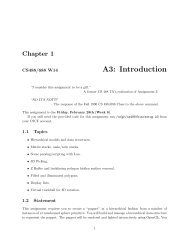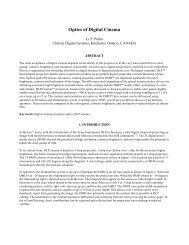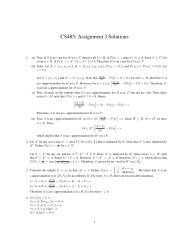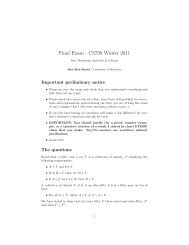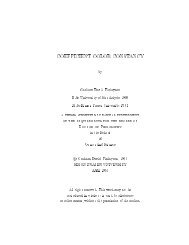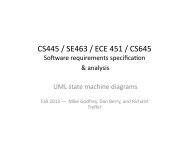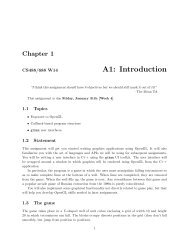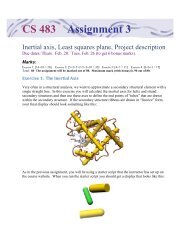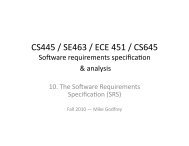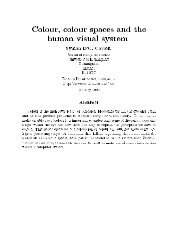Past Midterm and Exam Questions (PDF) - Student.cs.uwaterloo.ca ...
Past Midterm and Exam Questions (PDF) - Student.cs.uwaterloo.ca ...
Past Midterm and Exam Questions (PDF) - Student.cs.uwaterloo.ca ...
Create successful ePaper yourself
Turn your PDF publications into a flip-book with our unique Google optimized e-Paper software.
CS488/688 Introduction to Computer Graphi<strong>cs</strong> 57<br />
18.8 Quadratic Bézier Curves [Last Used: Winter 2009 Final]<br />
1. The diagram below shows three control points P 0 , P 1 <strong>and</strong> P 2 that together define a quadratic<br />
Bézier spline P (t), t ∈ [0, 1]. Use de Casteljau’s algorithm to evaluate the spline at t = 1 3 .<br />
Sketch the intermediate lines <strong>and</strong> points that are used in the algorithm <strong>and</strong> clearly label the<br />
point P ( 1 3 ).<br />
2. Based on the formula for an affine combination of two points, use de Casteljau’s algorithm to<br />
derive an explicit equation for P (t) in terms of P 0 , P 1 <strong>and</strong> P 2 .<br />
3. Suppose that we wish to place three additional control points Q 0 , Q 1 <strong>and</strong> Q 2 defining a second<br />
Bézier spline segment, parameterized over [1, 2]. Give formulas for whichever of the Qs are<br />
necessary to guarantee that the two curve segments will be joined with C 1 continuity.<br />
4. Suppose now that we have three control points P 0 , P 1 <strong>and</strong> P 2 where P 1 lies at the midpoint<br />
of the line segment joining P 0 <strong>and</strong> P 2 . Show that as the parameter t grows at a constant rate<br />
from 0 to 1, a particle tracing out the curve P (t) will move along the line from P 0 to P 2 with<br />
a constant velocity.<br />
18.9 Splines [Last Used: Winter 2011 Final<br />
(a) Draw <strong>and</strong> label four points P 0 , P 1 , P 2 <strong>and</strong> P 3 such th at the cubic Bézier curve P (t) derived<br />
from them is a simple, closed curve. Sketch the resulting curve freeh<strong>and</strong>, as accuratel y as<br />
you <strong>ca</strong>n. (A curve is closed if it starts <strong>and</strong> ends at the sam e point. A closed curve is simple<br />
if it never touches itself anyw here else.)<br />
(b) Explain why it would be impossible to construct a simple, closed cubic Bézier curve that has<br />
C 1 continuity everywhere. Incl ude a small diagram if you want.<br />
(c) The diagram below shows three B-Spline control points B 1 , B 2 <strong>and</strong> B 3 , arranged in a closed<br />
loop. These three control point s give rise to three cubic Bézier segments that meet each<br />
other with C 2 continuity. Draw <strong>and</strong> label the twelve Bézier control points {P 0 , P 1 , P 2 , P 3 },<br />
{Q 0 , Q 1 , Q 2 , Q 3 }, <strong>and</strong> {R 0 , R 1 , R 2 , R 3 }. (It doesn’t matter which segment gets the P s, which<br />
gets the Qs, <strong>and</strong> which gets the Rs, as long as they are labelled consistently.)



